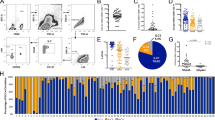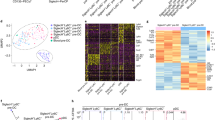Abstract
We have identified two cell subsets in human blood based on the lack of lineage markers (lin–) and the differential expression of immunoglobulin-like transcript receptor 1 (ILT1) and ILT3. One subset (lin–/ILT3+/ILT1+) is related to myeloid dendritic cells. The other subset (lin–/ILT3+/ILT1–) corresponds to 'plasmacytoid monocytes'. These cells are found in inflamed lymph nodes in and around the high endothelial venules. They express CD62L and CXCR3, and produce extremely large amounts of type I interferon after stimulation with influenza virus or CD40L. These results, with the distinct cell phenotype, indicate that plasmacytoid monocytes represent a specialized cell lineage that enters inflamed lymph nodes at high endothelial venules, where it produces type I interferon. Plasmacytoid monocytes may protect other cells from viral infections and promote survival of antigen-activated T cells.
This is a preview of subscription content, access via your institution
Access options
Subscribe to this journal
Receive 12 print issues and online access
$209.00 per year
only $17.42 per issue
Buy this article
- Purchase on Springer Link
- Instant access to full article PDF
Prices may be subject to local taxes which are calculated during checkout






Similar content being viewed by others
References
Muller-Hermelink, H.K., Stein, H., Steinmann, G. & Lennert, K. Malignant lymphoma of plasmacytoid T-cells. Morphologic and immunologic studies characterizing a special type of T-cell. Am. J. Surg. Pathol. 7, 849–862 (1983).
Prasthofer, E.F., Prchal, J.T., Grizzle, W.E. & Grossi, C.E. Plasmacytoid T-cell lymphoma associated with chronic myeloproliferative disorder. Am. J. Surg. Pathol. 9, 380– 387 (1985).
Facchetti, F., de Wolf-Peeters, C., van den Oord, J.J., de Vos, R. & Desmet, V.J. Plasmacytoid monocytes (so-called plasmacytoid T-cells) in Kikuchi's lymphadenitis. An immunohistologic study. Am. J. Clin. Pathol. 92, 42– 50 (1989).
Facchetti, F., De Wolf-Peeters, C., De Vos, R., van den Oord, J.J., Pulford, K.A. et al. Plasmacytoid monocytes (so-called plasmacytoid T cells) in granulomatous lymphadenitis. Hum. Pathol. 20, 588–593 (1989).
Facchetti, F., De Wolf-Peeters, C., van den Oord, J.J. & Desmet, V.J. Plasmacytoid monocytes (so-called plasmacytoid T cells) in Hodgkin's disease. J. Pathol. 158, 57–65 (1989).
Grouard, G. et al. The enigmatic plasmacytoid T cells develop into dendritic cells with interleukin (IL)-3 and CD40-ligand. J. Exp. Med. 185, 1101–1111 (1997).
Olweus, J. et al. Dendritic cell ontogeny: a human dendritic cell lineage of myeloid origin. Proc Natl. Acad. Sci. USA 94, 12551 –12556 (1997).
Rissoan, M.C. et al. Reciprocal control of T helper cell and dendritic cell differentiation. Science 283, 1183–1186 (1999).
Cella, M. et al. A novel inhibitory receptor (ILT3) expressed on monocytes, macrophages, and dendritic cells involved in antigen processing. J. Exp. Med. 185, 1743–1751 ( 1997).
Nakajima, H., Samaridis, J., Angman, L. & Colonna, M. Human myeloid cells express an activating ILT receptor (ILT1) that associates with Fc receptor gamma-chain. J. Immunol. 162, 5–8 (1999).
Tough, D.F., Borrow, P. & Sprent, J. Induction of bystander T cell proliferation by viruses and type I interferon in vivo. Science 272, 1947–1950 (1996).
Marrack, P., Kappler, J. & Mitchell, T. Type I Interferons Keep Activated T Cells Alive. J. Exp. Med. 189, 521–530 (1999).
Belardelli, F. et al. The induction of in vivo proliferation of long-lived CD44hi CD8+ T cells after the injection of tumor cells expressing IFN-alpha1 into syngeneic mice. Cancer Res. 58, 5795– 5802 (1998).
O'Doherty, U. et al. Dendritic cells freshly isolated from human blood express CD4 and mature into typical immunostimulatory dendritic cells after culture in monocyte-conditioned medium. J. Exp. Med. 178, 1067–1076 (1993).
O'Doherty, U. et al. Human blood contains two subsets of dendritic cells, one immunologically mature and the other immature. Immunology 82, 487–493 (1994).
Sallusto, F., Cella, M., Danieli, C. & Lanzavecchia, A. Dendritic cells use macropinocytosis and the mannose receptor to concentrate macromolecules in the major histocompatibility complex class II compartment: downregulation by cytokines and bacterial products. J. Exp. Med. 182 , 389–400 (1995).
Facchetti, F., De Wolf-Peters, C., Marocolo, D. & De Vos, R. Plasmacytoid monocytes in granulomatous lymphadenitis and in histiocytic necrotizing lymphadenitis. Sarcoidosis 8, 170– 171 (1991).
Grouard, G., Durand, I., Filgueira, L., Banchereau, J. & Liu, Y.J. Dendritic cells capable of stimulating T cells in germinal centres. Nature 384, 364–367 (1996).
Bjorck, P., Flores-Romo, L. & Liu, Y.J. Human interdigitating dendritic cells directly stimulate CD40-activated naive B cells. Eur. J. Immunol. 27, 1266–1274 (1997).
Girard, J.P. & Springer, T.A. High endothelial venules (HEVs): specialized endothelium for lymphocyte migration. Immunol. Today 16, 449–57 ( 1995).
Hafezi-Moghadan, A. & Ley, K. Relevance of L-selectin shedding for leucocyte rolling in vivo. J. Exp. Med. 189, 939–948 (1999).
Piali, L. et al. The chemokine receptor CXCR3 mediates rapid and shear-resistant adhesion-induction of effector T lymphocytes by the chemokines IP10 and Mig. Eur. J. Immunol. 28, 961– 972 (1998).
Farber, J.M. Mig and IP-10: CXC chemokines that target lymphocytes. J. Leukoc. Biol. 61, 246–257 ( 1997).
Dieu, M.C. et al. Selective recruitment of immature and mature dendritic cells by distinct chemokines expressed in different anatomic sites. J. Exp. Med. 188, 373–386 (1998).
Sallusto, F. et al. Rapid and coordinated switch in chemokine receptor expression during dendritic cell maturation. Eur. J. Immunol. 28, 2760–2769 (1998).
Banchereau, J. & Steinman, R.M. Dendritic cells and the control of immunity. Nature 392, 245–252 (1998).
Rogge, L. et al. Selective expression of an interleukin-12 receptor component by human T helper 1 cells. J. Exp. Med. 185, 825–31 (1997).
Cella, M. et al. Maturation, Activation, and Protection of Dendritic Cells Induced by Double-stranded RNA. J. Exp. Med. 189, 821–829 (1999).
Perussia, B., Fanning, V. & Trinchieri, G. A leukocyte subset bearing HLA-DR antigens is responsible for in vitro alpha interferon production in response to viruses. Nat. Immun. Cell Growth Regul. 4, 120– 137 (1985).
Chehimi, J. et al. Dendritic cells and IFN-alpha-producing cells are two functionally distinct non-B, non-monocytic HLA-DR+ cell subsets in human peripheral blood. Immunology 68, 488–490 (1989).
Fitzgerald-Bocarsly, P., Feldman, M., Mendelsohn, M., Curl, S. & Lopez, C. Human mononuclear cells which produce interferon-alpha during NK(HSV-FS) assays are HLA-DR positive cells distinct from cytolytic natural killer effectors. J. Leukoc. Biol. 43, 323–334 (1988).
Feldman, M. & Fitzgerald-Bocarsly, P. Sequential enrichment and immunocytochemical visualization of human interferon-alpha-producing cells. J. Interferon Res. 10,435– 46 (1990).
Fitzgerald-Bocarsly, P. Human natural interferon-alpha producing cells. Pharmacol. Ther. 60, 39–62 ( 1993).
Horny, H.P., Feller, A.C., Horst, H.A. & Lennert, K. Immunocytology of plasmacytoid T cells: marker analysis indicates a unique phenotype of this enigmatic cell. Hum. Pathol. 18, 28–32 (1987).
Facchetti, F. et al. Leukemia-associated lymph node infiltrates of plasmacytoid monocytes (so-called plasmacytoid T-cells). Evidence for two distinct histological and immunophenotypical patterns. Am. J. Surg. Pathol. 14, 101–112 (1990).
Facchetti, F. et al. Plasmacytoid monocytes in Jessner's lymphocytic infiltration of the skin. Am J. Dermatopathol. 12, 363 –369 (1990).
Facchetti, F., Marocolo, D., Morassi, M.L., Villanacci, V. & Grigolato, P.G. Cutaneous Kikuchi's disease. Am. J. Surg. Pathol. 15, 1012– 1014 (1991).
Facchetti, F. et al. Plasmacytoid T cells. Immunohistochemical evidence for their monocyte/macrophage origin. Am. J. Pathol. 133, 15–21 (1988).
Nederman, T., Karlstrom, E. & Sjodin, L. An in vitro bioassay for quantitation of human interferons by measurements of antiproliferative activity on a continuous human lymphoma cell line. Biologicals 18, 29–34 (1990).
Acknowledgements
We thank M. Dessing and A. Pickert (Basel Institute for Immunology) for assistance in cell sorting; F. Montero (Immunotech, Marseille) for IL-5Rα antibody; P. Lane (Birmingham Medical School, Birmingham, UK) and A. Vitiello (R.W. Johnson Pharmaceutical Research Institute, San Diego, California) for reagents; S. Gilfillan, H.-R. Rodewald, A. Rolink and F. Sallusto (Basel Institute for Immunology) for reviewing the manuscript. The Basel Institute for Immunology was founded and is supported by Hoffmann-La Roche, CH-4002 Basel.
Author information
Authors and Affiliations
Corresponding author
Rights and permissions
About this article
Cite this article
Cella, M., Jarrossay, D., Facchetti, F. et al. Plasmacytoid monocytes migrate to inflamed lymph nodes and produce large amounts of type I interferon. Nat Med 5, 919–923 (1999). https://doi.org/10.1038/11360
Received:
Accepted:
Issue Date:
DOI: https://doi.org/10.1038/11360
This article is cited by
-
A necroptosis-independent function of RIPK3 promotes immune dysfunction and prevents control of chronic LCMV infection
Cell Death & Disease (2023)
-
One disease, two faces: clonally-related AML and MPDCP with skin involvement
Annals of Hematology (2023)
-
Ly6D+Siglec-H+ precursors contribute to conventional dendritic cells via a Zbtb46+Ly6D+ intermediary stage
Nature Communications (2022)
-
Nutritional immunity: the impact of metals on lung immune cells and the airway microbiome during chronic respiratory disease
Respiratory Research (2021)
-
Blastic Plasmacytoid Dendritic Cell Neoplasm: Progress in Cell Origin, Molecular Biology, Diagnostic Criteria and Therapeutic Approaches
Current Medical Science (2021)



